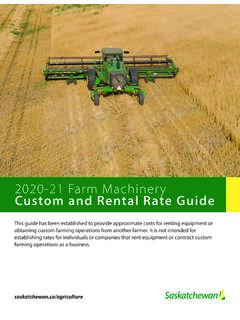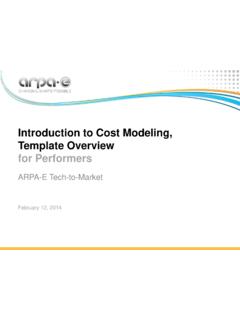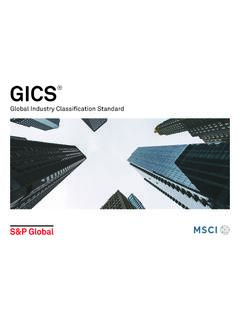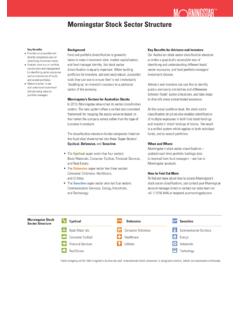Transcription of The Costs and Benefits of Advanced Maintenance in ... - NIST
1 NIST AMS 100-18 The Costs and Benefits of Advanced Maintenance in Manufacturing Douglas S. Thomas This publication is available free of charge from: NIST AMS 100-18 The Costs and Benefits of Advanced Maintenance in Manufacturing Douglas S. Thomas Applied Economics Office Engineering Laboratory This publication is available free of charge from: April 2018 Department of Commerce Wilbur L. Ross, Jr., Secretary National Institute of Standards and Technology Walter Copan, NIST Director and Under Secretary of Commerce for Standards and Technology Certain commercial entities, equipment, or materials may be identified in this document in order to describe an experimental procedure or concept adequately.
2 Such identification is not intended to imply recommendation or endorsement by the National Institute of Standards and Technology, nor is it intended to imply that the entities, materials, or equipment are necessarily the best available for the purpose. Photo Credit: The Chrysler 200 Factory Tour, an interactive online experience using Google Maps Business View technology, takes consumers inside the new 5-million-square-foot Sterling Heights Assembly Plant for a behind-the-scenes peek at how the 2015 Chrysler 200 is built. This publication is available free of charge from: Contents Executive Summary ..iii Introduction .. 1 Literature and Data Overview .. 3 Literature on Predictive Maintenance 3 Relevant Data .. 13 Annual Survey of Manufactures and Economic Census.
3 13 County Business Patterns .. 14 Occupational Employment 15 Economic Input-Output Data .. 15 Potential Methods and Data Needs .. 17 Direct Maintenance and Repair Costs .. 17 Downtime Costs .. 20 Lost Sales due to Delays/Quality 23 Rework and Defects .. 23 Breaking Down Predictive, Preventive, and Reactive Maintenance Costs .. 24 Required Sample Size for Data 26 Feasibility of Data 31 Summary and Conclusions .. 33 Bibliography .. 34 i List of Figures This publication is available free of charge from: Figure : Mechanisms to Improve Efficiency in the Life-Cycle of a 1 Figure : Range of Impacts Identified in Various Publications for Implementing Advanced Figure : Objectives and Prevalent Barriers to the Adoption of Advanced Maintenance Figure : Margin of Error Graphed with Standard Deviation of Maintenance Cost and Figure : Manufacturing Maintenance Budget Distributions, Sweden.
4 4 Maintenance Techniques, Percent Change .. 6 Techniques, Percent of Respondents .. 10 Figure : Number of Establishments by Employment, 15 Figure : Data Map and Needs .. 18 Figure : Required Sample Size by Margin of Error and Confidence Interval .. 27 Figure : Cumulative Frequency Graph, Monte Carlo Analysis .. 28 Sample Size from Monte Carlo Analysis (90 % Confidence Interval only).. 29 List of Tables Table 2-1: Characteristics of Maintenance Costs from a Selection of Articles, Various Countries/Industries .. 5 Table 2-3: Maintenance Type by Competitive Priority (Numbers Indicate the Number of Table 2-2: Characteristics of Maintenance by Type .. 7 Respondents out of a Total of 46).. 12 Table 3-1: Assumptions for Monte Carlo Analysis (Triangular distributions).. 28 ii This publication is available free of charge from: Executive Summary The manufacturing atmosphere is continually changing with new technologies and standards being swiftly developed.
5 Firms create competitive advantages using their knowledge, skills, supply chains, and processes to create superior products at lower prices. In such a competitive environment, efficient machinery Maintenance methods can mean the difference between a thriving profitable firm and one that loses money and sales. Currently, at the national level there is limited understanding of the Costs and losses associated with machinery Maintenance or the different machinery Maintenance techniques. This report examines the literature and data available for estimating the Costs and losses relevant to different manufacturing Maintenance techniques. It extends further to identify the data needed for making such estimates and the feasibility of collecting the relevant data. This report focuses on, but is not limited to, four categories of manufacturing: machinery , computer and electronic products, electrical equipment, and transportation equipment manufacturers.
6 Census data estimates that $50 billion was spent on Maintenance and repair in 2016; however, this represents outsourcing of Maintenance and repair, including that for buildings. It excludes internal expenditures on labor and materials. Estimates for Maintenance Costs made in journals and articles use a wide range of metrics. For instance, some articles discuss the percent of cost of goods sold, percent of sales, cost of ownership, or cost of manufacturing. Additionally, the values provided have a wide range. For example, Maintenance is estimated to be between 15 % and 70 % of the cost of goods sold. The estimates are made using data from various countries, which may or may not have similarities to the US. A rough estimate of machinery Maintenance Costs might be made using a combination of datasets from the US Census Bureau and Bureau of Economic Analysis.
7 This would include labor and material Costs for Maintenance and repair of machinery but would exclude items such as losses and downtime. The potential effect on Maintenance Costs from adopting predictive Maintenance techniques is not well documented at the national level. The estimates that have been made at the firm level show the impacts of predictive Maintenance have a wide range of metrics and, within each metric, a wide range of values. These studies originate from various countries. There are estimates for the reduction in Maintenance Costs , defects, breakdowns, accidents, and downtime along with estimates of the increase in productivity and output. The reduction in Maintenance cost can range from 15 % to 98 % and the return on investment is, generally, estimated to be favorable. A number of data items would need to be collected to estimate the Costs and losses associated with Maintenance at the national level, including the following: Direct Maintenance and repair Costs (discussed in Section ) o Labor (discussed in Section ) o Materials (discussed in Section ) Indirect Costs (discussed in Section through ) o Downtime (discussed in Section ) iii This publication is available free of charge from.
8 O Lost sales due to quality/delays (discussed in Section ) o Rework/defects (discussed in Section ) Separating Maintenance types ( , predictive, preventive, and reactive) (discussed in Section ) Sample size needed for data collection (discussed in Section ) Direct Maintenance and repair Costs include the cost of labor and materials, along with cascading effects, which refers to subsequent damage caused by a breakdown of a machine ( , repair). Downtime includes the capital and labor Costs that are the result of downtime related to Maintenance . Rework/defects is the lost revenue or additional expenditures associated with defects that result from Maintenance issues. Downtime due to Maintenance issues might have an impact on inventory Costs , which are not examined in this study. Each of the Costs and losses must be separated into the different Maintenance techniques utilizing the insight of Maintenance personnel.
9 Data collection requires that manufacturers are willing and able to provide data and that there is a sufficient survey sample size that represents the manufacturing sectors as a whole. Depending on the standard deviation, confidence interval, and accepted margin of error, a sample size of 77 is estimated, but could reasonably range from 14 to 140. Discussions with manufacturing Maintenance personnel suggested that they are willing and able to provide estimates or approximations of the data needed for estimating the manufacturing Costs /losses relevant to Advanced Maintenance techniques. However, some discussants expressed uncertainty about the willingness to provide some of the data. Some items were not tracked; however, most believed that an approximation could be provided in these cases. iv Introduction This publication is available free of charge from: Trade associations and public research efforts in manufacturing have Benefits to both producers and consumers.
10 That is, research efforts improve the efficiency in both the production and use of products. Costs and losses are reduced for manufacturers ( , efficiency in production) while consumers have reliable long-lasting energy efficient products at lower prices ( , efficiency in product function). Manufacturing research efforts can and often are described in varying ways, such as improving quality, reliability, improving the quality of life, or even competitiveness, but these descriptors, generally, amount to reducing resource consumption for producers and consumers. In addition to resources in the form of inputs, there are also unintended negative impacts of producing and using products, such as air pollution, which affect third-parties. These negative impacts are often referred to as negative externalities and efforts to improve efficiency (both in production and use) frequently aim to reduce these impacts.















